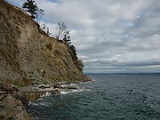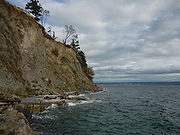
Feeder bluff
Encyclopedia

Puget Sound
Puget Sound is a sound in the U.S. state of Washington. It is a complex estuarine system of interconnected marine waterways and basins, with one major and one minor connection to the Strait of Juan de Fuca and the Pacific Ocean — Admiralty Inlet being the major connection and...
region. The concept was apparently first discussed at Western Washington University
Western Washington University
Western Washington University is one of six state-funded, four-year universities of higher education in the U.S. state of Washington. It is located in Bellingham and offers bachelor's and master's degrees.-History:...
. The term feeder bluff has been applied to certain coastal cliffs or headlands that provide sediment to beaches down current as the result of wave action on the bluff.
A bluff will be more susceptible to erosion if the sediment is unconsolidated, and more resistant in crystalline rocks, like granite. Rocks that are heavily fractured are also very likely to suffer from erosion because the water can flow between the cracks to speed up the process. A bluff will retreat towards land as the erosion processes continue.
The term has not been extensively researched; specific criteria have not been developed to distinguish "feeder bluffs" from other types of bluffs
Cliff
In geography and geology, a cliff is a significant vertical, or near vertical, rock exposure. Cliffs are formed as erosion landforms due to the processes of erosion and weathering that produce them. Cliffs are common on coasts, in mountainous areas, escarpments and along rivers. Cliffs are usually...
; and quantities and rates of sediment
Sediment
Sediment is naturally occurring material that is broken down by processes of weathering and erosion, and is subsequently transported by the action of fluids such as wind, water, or ice, and/or by the force of gravity acting on the particle itself....
supply to beaches and the littoral drift are unspecified and unknown. The overall contribution of "feeder bluffs" to beach processes, unlike the well-researched effects of sediment from rivers, is still undetermined.

